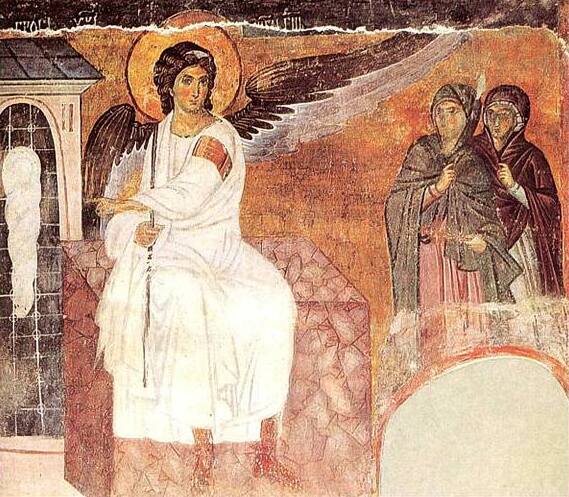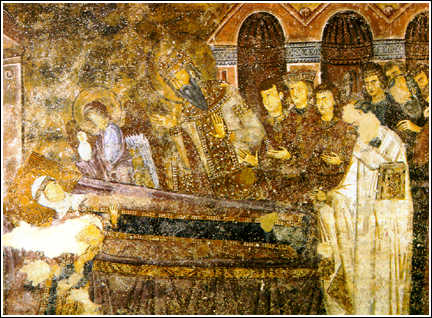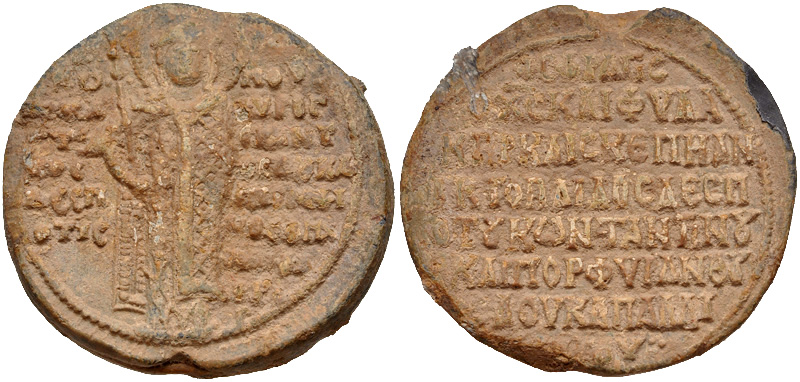|
Simonida
Simonida Nemanjić ( sr-cyr, Симонида Немањић; c. 1294 – after 1336), born Simonis Palaiologina ( el, Σιμωνίς Παλαιολογίνα, sr. Симонида Палеолог, ''Simonida Paleolog''), was a Byzantine princess and queen consort of the Kingdom of Serbia, wife of Serbian king Stefan Milutin (r. 1282–1321). Queen Simonida was a daughter of the Byzantine Emperor Andronikos II Palaiologos (r. 1282–1328) and Irene of Montferrat. In Medieval Serbia Queen Simonida is best remembered as a patron of Fine Arts, Arts and Letters. Life Princess Simonida was born in Constantinople ca. 1294. In 1298, when a result of a Byzantine defeat, Emperor Andronikos II promised a marriage alliance to the Serbian ruler Milutin. The Orthodox Diocese in Constantinople opposed the marriage, but the emperor was determined to do so, and in late 1298 he sent his trusted minister Theodore Metochites to Serbia to conduct the negotiations. On his part, King Milutin to ... [...More Info...] [...Related Items...] OR: [Wikipedia] [Google] [Baidu] |
Andronikos II Palaiologos
, image = Andronikos II Palaiologos2.jpg , caption = Miniature from the manuscript of George Pachymeres' ''Historia'' , succession = Byzantine emperor , reign = 11 December 1282 –24 May 1328 , coronation = 8 November 1272 , cor-type1 = Coronation , regent = Michael IX Palaiologos , reg-type = Co-emperor , predecessor = Michael VIII Palaiologos (alone) , successor = Andronikos III Palaiologos , spouse = Anna of HungaryYolande of Montferrat , issue = Michael IX PalaiologosConstantine Palaiologos John PalaiologosTheodore I, Marquis of MontferratDemetrios Palaiologos Simonis (Simonida Nemanjić), Queen of SerbiaIrene Palaiologina (wife of John II Doukas), Sebastokratorissa of Thessaly , issue-link = #Family , issue-pipe = more... , dynasty = Palaiologos , father = Michael VIII Palaiologos , mother = Theodora Palaiologina , birth_date = 25 March 1259 , birth_place = Nicaea, Empire of Nicaea( ... [...More Info...] [...Related Items...] OR: [Wikipedia] [Google] [Baidu] |
Serbian Art
Serbian art refers to the visual arts of the Serbs and their nation-state Serbia. The medieval heritage includes Byzantine art, preserved in architecture, frescos and icons of the many Serbian Orthodox monasteries. In the Early modern period, Serbian visual arts began to be influenced by Western art, culminating in the Habsburg monarchy in the late 18th century. The beginning of modern Serbian art is placed in the 19th century. Many Serbian monuments and works of art have been lost forever due to various wars and peacetime marginalizations. Prehistory Currently, Europe's oldest known civilization was discovered in Serbia, namely Lepenski Vir and Vinča culture. In Serbia, Archaeological Sites of Exceptional Importance (Serbia) are numerous and have the highest level of state protection under the Law on Cultural Heritage. See: Prehistoric sites in Serbia and Prehistory of Southeastern Europe for artifacts and sculpture found at the archeological sites of Lepenski Vir. Roman peri ... [...More Info...] [...Related Items...] OR: [Wikipedia] [Google] [Baidu] |
Ana Terter
Ana Terter (Bulgarian and sr-cyr, Ана Тертер; died after 1304) was a Bulgarian princess and Queen consort of Serbia (1284–1299). She was the fourth wife of King Stefan Uroš II Milutin of Serbia. Her marriage to Stefan Milutin is dynastic, ie foreseen by the Deževa Agreement. According to George Pachymeres, Ana was "''the daughter of Terter, borne to him by the sister of Asen''. ''The sister of Asen'' was Kira Maria- second wife of George I Terter. According another theory she was the daughter of George Terter and his first wife Maria,Pavlov, Plamen making Ana a full sister of Bulgarian tsar Theodore Svetoslav. In 1284 Ana married King Stefan Uroš II Milutin of Serbia as his third wife. They had two children: * Stefan Uroš III Dečanski, who succeeded as king of Serbia *Anna Neda of Serbia, who married Michael Shishman of Bulgaria. In 1299 Stefan Uroš II Milutin divorced Ana in order to marry Simonida Simonida Nemanjić ( sr-cyr, Симонида Нема� ... [...More Info...] [...Related Items...] OR: [Wikipedia] [Google] [Baidu] |
Kingdom Of Serbia (medieval)
The Kingdom of Serbia ( sr, / ), or the Serbian Kingdom ( sr, / ), was a medieval Serbian state that existed from 1217 to 1346 and was ruled by the Nemanjić dynasty. The Grand Principality of Serbia was elevated with the regal coronation of Stefan Nemanjić as king, after the reunification of Serbian lands. In 1219, Serbian Orthodox Church was reorganized as an autocephalous archbishopric, headed by Saint Sava. The kingdom was proclaimed an Serbian Empire, empire in 1346, but kingship was not abolished as an institution, since the title of a king was used as an official designation for a co-ruler of the emperor. Background The regal coronation of Stefan Nemanjić in 1217 was not a novelty in Serbian history, since there had already been a long tradition of kingship among previous Serbian rulers, centered in Duklja (11th century). During the Nemanjić era, the previous Serbian kingdom in Duklja was referred to as the "Old Kingdom of our forefathers" and such views were al ... [...More Info...] [...Related Items...] OR: [Wikipedia] [Google] [Baidu] |
List Of Serbian Consorts
This is a list of consorts of Serbian monarchs during the history of Serbia. Middle Ages Princess- and Grand Princess consorts (–1217) Queen consorts Nemanjić dynasty (1217–1365) Empress consorts Nemanjić dynasty (1346–71) Magnate era Mrnjavčević family (1365–95) Lazarević family (1371–1402) Despotess consorts Lazarević dynasty (1402–27) Branković dynasty (1427–59) Kotromanić dynasty (1459) Despotess consorts (in exile) Branković dynasty (1459–1504) Berislavić dynasty (1504–36) Bakić family (1537) Modern Consort of the Grand Leader Karađorđević dynasty (1804–13) Princess consorts Obrenović dynasty (1815–42) Karađorđević dynasty (1842–58) Obrenović dynasty (1858–82) Queen consorts Obrenović dynasty (1882–1903) Queen consort of Serbs, Croats and Slovenes Karađorđević dynasty (1918–29) Queen consorts of Yugoslavia Karađorđević dynasty (1929–45) See also *List of princesses of Serbia Ref ... [...More Info...] [...Related Items...] OR: [Wikipedia] [Google] [Baidu] |
Stefan Milutin
Stefan Uroš II Milutin ( sr-cyr, Стефан Урош II Милутин, Stefan Uroš II Milutin; 1253 – 29 October 1321), known as Stefan Milutin ( sr-cyr, Стефан Милутин, Stefan Milutin), was the King of Serbia between 1282–1321, a member of the Nemanjić dynasty. He was one of the most powerful rulers of Serbia in the Middle Ages. Milutin is credited with strongly resisting the efforts of Byzantine Emperor Michael VIII Palaiologos to impose Roman Catholicism on the Balkans after the Union of Lyons in 1274. During his reign, Serbian economic power grew rapidly, mostly due to the development of mining. He founded Novo Brdo, which became an internationally important silver mining site. As most of the Nemanjić monarchs, he was proclaimed a saint by the Serbian Orthodox Church with a feast day on October 30. Milutin appears in the Dante Alighieri's narrative poem ''Divine Comedy''. Early life He was the youngest son of King Stefan Uroš I and his wife, ... [...More Info...] [...Related Items...] OR: [Wikipedia] [Google] [Baidu] |
Milan Rakić
Milan Rakić (Serbian Cyrillic: Милан Ракић; 18 September 1876 – 30 June 1938) was a Serbian poet-diplomat and academic. He focused on dodecasyllable and hendecasyllable verse, which allowed him to achieve beautiful rhythm and rhyme in his poems. He was quite a perfectionist and therefore only published three collections of poems (1903, 1912, 1924). He wrote largely about death and non-existence, keeping the tone sceptical and ironic. Some of his most well-known poems are ''An Honest Song'' (Iskrena pesma), ''A Desperate Song'' (Očajna pesma), ''Jefimija'', ''Simonida'' and ''At Gazi-Mestan'' (Na Gazi-Mestanu). He was a member of the Serbian Royal Academy (1934). Biography Early life Rakić was born on 18 September 1876 in Belgrade to father Mita and mother Ana (née Milićević). His father, educated abroad, was Serbia's Minister of Finance (1888) and his mother was the daughter of Serbian writer Milan Milićević. He finished elementary school (grade school) an ... [...More Info...] [...Related Items...] OR: [Wikipedia] [Google] [Baidu] |
Palaiologos
The House of Palaiologos ( Palaiologoi; grc-gre, Παλαιολόγος, pl. , female version Palaiologina; grc-gre, Παλαιολογίνα), also found in English-language literature as Palaeologus or Palaeologue, was a Byzantine Greek family that rose to nobility and produced the last and longest-ruling dynasty in the history of the Byzantine Empire. Their rule as Emperors and Autocrats of the Romans lasted almost two hundred years, from 1259 to the Fall of Constantinople in 1453. The origins of the family are unclear. Their own medieval origin stories ascribed them an ancient and prestigious origin in ancient Roman Italy, descended from some of the Romans that had accompanied Constantine the Great to Constantinople upon its foundation in 330. It is more likely that they originated significantly later in Anatolia since the earliest known member of the family, possibly its founder, Nikephoros Palaiologos, served as a commander there in the second half of the 11th centur ... [...More Info...] [...Related Items...] OR: [Wikipedia] [Google] [Baidu] |
Irene Of Montferrat
Yolande of Montferrat ( – 1317 in Constantinople) (also known as Violante, then Empress Irene) was the second wife of Andronikos II Palaiologos and thus Empress of the Byzantine Empire. She was the heir of the Margraviate of Montferrat. Born in Casale, she was daughter of William VII, Marquess of Montferrat and his second wife Beatrice of Castile. Her maternal grandparents were King Alfonso X of Castile and his wife Violante of Aragon. Yolande (variation of Violante) was named after her grandmother. In 1284, Andronikos II, a widower by his first marriage with Anna of Hungary, married Yolanda (who was renamed Eirene as Empress). She and Andronikos II were distant cousins, both being descendants of Andronikos Doukas Angelos (ca. 1122–1185). With her, Eirene brought the Montferrat rights to the kingdom of Thessalonica, a dominion that, despite having been conquered half-a-century before Eirene's birth by the Byzantine state of Epirus, was still claimed by its short-lived (12 ... [...More Info...] [...Related Items...] OR: [Wikipedia] [Google] [Baidu] |
Constantine Palaiologos (son Of Andronikos II)
Constantine Doukas Komnenos Palaiologos ( gr, Κωνσταντῖνος Δούκας Κομνηνός Παλαιολόγος; 1278/81–1334/35) was a Byzantine prince of the Palaiologos dynasty, who received the supreme title of Despot and served as provincial governor. Constantine was the second son of Emperor Andronikos II Palaiologos (r. 1282–1328) and his first wife, Empress Anna of Hungary. He was born sometime between 1278 and 1281. As his father was already a reigning co-emperor alongside Michael VIII Palaiologos, he was styled a ''porphyrogennetos'' ("purple-born"), as attested on his seals. In 1294 he was named Despot, the highest court rank in the Byzantine Empire, on the occasion of his first marriage to Eudokia, the daughter of Theodore Mouzalon. In 1305, he fought in the disastrous Battle of Apros against the Catalan Company. In 1317, he intercepted his half-sister Simonida, the queen-consort of Serbia, who wished to retire to a monastery after the death of ... [...More Info...] [...Related Items...] OR: [Wikipedia] [Google] [Baidu] |
Thessalonica
Thessaloniki (; el, Θεσσαλονίκη, , also known as Thessalonica (), Saloniki, or Salonica (), is the second-largest city in Greece, with over one million inhabitants in its metropolitan area, and the capital of the geographic region of Macedonia, the administrative region of Central Macedonia and the Decentralized Administration of Macedonia and Thrace. It is also known in Greek as (), literally "the co-capital", a reference to its historical status as the () or "co-reigning" city of the Byzantine Empire alongside Constantinople. Thessaloniki is located on the Thermaic Gulf, at the northwest corner of the Aegean Sea. It is bounded on the west by the delta of the Axios. The municipality of Thessaloniki, the historical center, had a population of 317,778 in 2021, while the Thessaloniki metropolitan area had 1,091,424 inhabitants in 2021. It is Greece's second major economic, industrial, commercial and political centre, and a major transportation hub for Greece and south ... [...More Info...] [...Related Items...] OR: [Wikipedia] [Google] [Baidu] |
Ohrid
Ohrid ( mk, Охрид ) is a city in North Macedonia and is the seat of the Ohrid Municipality. It is the largest city on Lake Ohrid and the List of cities in North Macedonia, eighth-largest city in the country, with the municipality recording a population of over 42,000 inhabitants as of 2002. Ohrid is known for once having 365 churches, one for each day of the year, and has been referred to as a "Jerusalem of the Balkans"."The Mirror of the Macedonian Spirit, Zlate Petrovski, Sašo Talevski, Napredok, 2004, , page 72: "... and Macedonia in the Cathedral Church St. Sofia in the Macedonian Jerusalem — Ohrid..." The city is rich in picturesque houses and monuments, and tourism is predominant. It is located southwest of Skopje, west of Resen (town), Resen and Bitola. In 1979 and in 1980 respectively, Ohrid and Lake Ohrid were accepted as Cultural and Natural World Heritage Sites by UNESCO. Ohrid is one of only 28 sites that are part of UNESCO's World Heritage that are Cultu ... [...More Info...] [...Related Items...] OR: [Wikipedia] [Google] [Baidu] |





